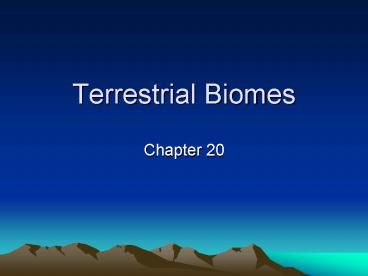Terrestrial Biomes PowerPoint PPT Presentation
1 / 32
Title: Terrestrial Biomes
1
Terrestrial Biomes
- Chapter 20
2
Biogeographical Realms
- Regions of the world where a group of plant and
animal species have evolved - Correspond to the continents
- Barriers to migration
- Topography
- Climate
Fig. 20.1
3
Biogeographical Realms
http//www.activityvillage.co.uk/images/map.jpg
4
Ecotones
- The boundary between two ecosystems is an ecotone
- Transition zone rather than a sharp boundary
- Zones of shared traits
- Areas of high biodiversity
- Area of tension
Fig. 10.14
5
Biomes
- A biome is a large, stable terrestrial ecosystem
characterized by specific plant and animal
communities. - Each biome is usually named for its dominant
vegetation - There are six broad biomes on Earth
6
Terrestrial Biomes
- Forest
- Savanna
- Grassland
- Shrubland
- Desert
- Tundra
- These biomes are divided into more specific
vegetation units called formation classes - Refer to the dominant plants in each terrestrial
ecosystem
7
Life-Form Designations
- Bryophytes (mosses, lichens)
- Epiphytes (use other plants for support)
- Thallophytes (bacteria, fungi, etc)
- Trees
- Lianas (vines)
- Shrubs
- Herbs
Based on outward physical properties of
individual plants or the general form and
structure of vegetation cover
8
Major Terrestrial Biomes
Fig. 20.3
9
Earths Major Terrestrial Biomes
- Equatorial and Tropical Rain Forest
- Tropical Seasonal Forest and Scrub
- Tropical Savanna
- Midlatitude Broadleaf and Mixed Forest
- Needleleaf Forest and Montane Forest
- Temperate Rain Forest
- Mediterranean Shrubland
- Midlatitude Grasslands
- Deserts
- Arctic and Alpine Tundra
10
Equatorial and Tropical Rain Forest
- Tropical Climate
- Warm all year
- High precipitation
- Water surplus
Figure 20.5
11
Rainforest Canopy
Fig 20.4
12
Vegetation
Figure 20.5
Figure 20.4
13
Tropical Seasonal Forest Scrub
14
Tropical Seasonal Forest and Scrub
- Tropical Monsoon, Tropical Savanna climate
- Seasonal precipitation
- Variable, warm temp.
- Seasonal water surplus and deficits
Samburu Reserve Kenya
Figure 20.7
15
Vegetation
- Transitional between rain forest and grasslands
- Broadleaf evergreen and deciduous
- Open parkland to dense undergrowth
- Acacias and thorn trees
Samburu Reserve Kenya
Figure 20.7
16
Tropical Savanna
17
Tropical Savanna
- Tropical Savanna climate
- Precipitation lt 6 mo
- Water deficits
- Xerophytic vegetation
- Fire associated vegetation
NASA Earth Observatory
Serengeti Plains of Tanzania
18
Midlatitude Broadleaf Mixed Forest
19
Midlatitude Broadleaf Mixed Forest
- Humid Subtropical warm summer climate
- Humid Continental warm summer
- Variable precipitation/ summer maximum
- Temperate w/cold season
- Mixture of broadleaf deciduous and needleleaf
evergreens
Figure 20.9
20
Needleleaf and Montane Forest
21
Needleleaf and Montane Forest
- Also called Boreal and Taiga
- Dominate in high latitudes and altitudes
- Short growing season
- Long winters
- Moderate rainfall
- Needleleaf conifers
- Pine
- Spruce
- Larch
- Fir
Figure 20.10
22
Temperate Rainforest
23
Temperate Rain Forest
- Marine West Coast climate
- High precipitation
- Mild temperatures
- Low tree species diversity
- Evergreen and deciduous trees
- Coastal redwoods
Figure 20.13
24
Mediterranean Shrubland
25
Mediterranean Shrubland
- Mediterranean dry summer climate
- Cool wet winters
- Hot, dry summers
- Short shrubs
- Sclerophyllous vegetation
- Grassy woodlands
- Chaparral vegetation
Figure 20.14
26
Midlatitude Grasslands
27
Midlatitude Grasslands
- Humid subtropical Humid continental/ hot summer
climate - Continental temperature
- Tallgrass prairies
- Shortgrass steppes
- Grain farming
Figure 20.15
Figure 20.16
28
Warm Deserts
29
Warm Deserts
- Desert arid climate
- Little precipitation
- High temperatures
- Xerophytic plants
- Cacti
- Succulents
- Dry shrubs
Figure 20.17
30
Cold Deserts
- Steppe and semi-arid climate
- Higher latitudes
- Hot summers
- Hot days/cool nights
- Light winter snows
- Short grass
- Dry shrubs
http//savanna.lternet.edu
31
Arctic and Alpine Tundra
32
Arctic and Alpine Tundra
- Tundra, Subartic Climate
- Cold and dry
- Dwarf shrubs
- Sedges
- Mosses
- Lichens
- Short grasses
- Alpine meadows
Figure 20.18

